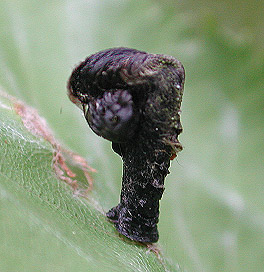Pistol Casebearer
Coleophora atromarginata (most likely)
June 15, 2004
I found this larval case on a cherry leaf a couple weeks ago. I brought it inside to see what would pop out of it.
Many of the Coleophoridae are leaf miners, meaning the larvae feed in between the layers of the leafs. They often build a case out of silk or a combination of silk, frass and leaf in which they live and pupate. Some species can be identified by the shape of that case.
The adult moth eclosed on June 15. It's a wispy little thing that reminds me a bit of the plume moths. I like the barring on the antennae!
There are over thirty different Coleophorids listed in CT. I contacted Jean-Francois Landry, a Canadian Entomologist who specializes in this family. He was kind enough to tell me more about them and this particular moth. I felt his response (slightly edited) to my query was worth including on this page!
You are right, this looks like Coleophora atromarginata. To be absolutely certain, the dissected out genitalia (from the preserved adult) would have to be examined because there are several very similar species. But the external appearance, the larval case and host plant match. Coleophora is a very large genus with hundreds of species in the USA, the majority of which are still nameless and undescribed. Although about 30 species of Coleophora are recorded from CT, actually there should be over 80 of them, but most require specialized searching or collecting to find them.
From the second instar onward coleophorid larvae spend their entire life in a portable case that they make, using silk, host plant material, or a combination of both (with no variation within species). Case shape and construction is very often species specific, particularly when coupled with host plant. Atromarginata belongs to the so-called "pistol-case" group, named after the resemblance of the case to a small pistol. Pistol cases are made up entirely of silk produced by the larva and hardened by a secretion of unknown composition (which gives it its black coloration). Cases are progressively enlarged by the growing larvae, and some species abandon their early, small case to make a new larger one, whereas other species simply enlarge progressively the same case. On your photo you can see what look like fine concentric lines on the case, which are the "growth" lines indicating the layers of silk added by the larva. Larvae move around with their cases, which they never leave, much like shell snails. Mature larvae typically leave their feeding sites and upon finding a suitable place (twig, branch, stem, substrate, ground debris, depending on the species) will attach the case with a thick pad of silk, turn around 180 degrees inside the case and pupate in there. As you saw, the adult emerges at the opposite end of the case through flaps (2 or 3 flaps depending on the species). Some species, such as yours, overwinter as fully grown larvae, others need to feed in the spring to complete their development.
Despite this appearance of protection from predators and the like, Coleophora larvae are heavily parasitized by hymenopterous parasites (braconid wasps most often). You are lucky to have obtained an adult moth out of the case you found, rather than a parasite!
